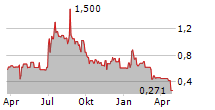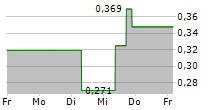
CHICAGO, IL / ACCESS Newswire / January 22, 2025 / Cosmos Health Inc. ("Cosmos Health" or the "Company') (NASDAQ:COSM), a diversified, vertically integrated global healthcare group engaged in innovative R&D, owner of proprietary pharmaceutical and nutraceutical brands, manufacturer and distributor of healthcare products, and operator of a telehealth platform, announced today that it has secured buy-out rights and exclusive licensing for two patented anticancer drugs targeting, among others, prostate, ovarian, and colorectal cancers.
Both of these innovative anticancer therapies, developed through cutting-edge oncology research, are protected by international patents and set to commence Clinical Phase I trials. The first therapy is safeguarded by a WIPO patent (WO 2017/001439) and is valid in key markets including the EU, USA, Canada, Japan, China, and Australia. The second therapy is covered by an EU patent (EP3484892) and has been internationally filed under WO 2018/011414 A1, with a focus on major markets such as the USA, Canada, Japan, China, and Australia.
Cosmos Health will oversee further development and commercialization of the two drugs.
This transaction significantly strengthens Cosmos Health's portfolio, enabling the Company to address critical unmet needs in oncology while unlocking substantial long-term value for shareholders.
Independent Valuation
Cosmos Health engaged a leading global audit and advisory firm to assess the fair value of the patents, in accordance with international accounting standards.
Based on the current EUR-USD exchange rate, the fair value in USD is approximately $24.61 million, with a range of $22.80 million to $26.55 million. This valuation is based on the current pre-clinical phase, and any advancements toward commercialization are expected to significantly positively impact future valuations.
Immediately Accretive
The Company has the option to buy out the patents for a fixed price of approximately $7.81 million (€7.5 million) at any time it deems appropriate or to license the distribution rights to third parties at its discretion.
The buyout price represents a significant discount to the patents' fair value and has the potential to add approximately $16.80 million to the Company's net worth, based on the valuation midpoint, contingent upon the exercise of the buyout rights and assuming no other changes to current conditions.
Global Market
The global oncology market continues to demonstrate robust growth, driven by advancements in targeted treatments, the increasing adoption of immunotherapy, and rising investments in cancer research. According to Grand View Research, the global ovarian cancer drug market size alone is projected to reach $6.3 billion by 2030, growing at a compound annual growth rate (CAGR) of 14.6%. Similarly, the prostate cancer therapeutics market is expected to reach $21.48 billion, with a CAGR of 8.4%, while the colorectal cancer therapeutics market is forecasted to achieve $16.7 billion, growing at a CAGR of 4.7% by the same year. Collectively, these areas represent critical opportunities for innovation and investment in oncology treatments. Additionally, the broader cancer immunotherapy market is projected to surpass $224 billion by 2030, reflecting growing demand for therapies addressing drug resistance, late-stage progression, and cancers with specific genetic mutations.
Greg Siokas, CEO of Cosmos Health, stated: "This agreement represents a transformative moment for Cosmos. By securing these two innovative, patented anticancer drugs, we are not only broadening our portfolio but also reaffirming our dedication to addressing some of the most pressing challenges in oncology. These compounds have the potential to significantly impact cancer treatment paradigms, and we are excited to lead their journey through clinical development and beyond.
I brokered this deal by securing a highly discounted price relative to fair market value, making it immediately accretive to Cosmos Health shareholders, of whom I remain one of the largest. Investing in R&D is part of our DNA, and this strategic move, along with the recent appointment of our new Head of Oncology, underscores our focused approach to advancing cancer treatments. In oncology and beyond, we are committed to delivering cutting-edge therapeutic solutions, advancing global healthcare standards, and transforming Cosmos into an R&D powerhouse."
About the Drugs
Below is a detailed analysis of the two drugs secured by Cosmos Health.
Abstract #1: ESTERS OF STEROIDAL LACTAM AND BIS(2-CHLOROETHYL) AMINOPHENOXY PROPANOIC ACID DERIVATIVES; Patent International Publication number: WO2017/001439A1 (PCT/EP 2016/065071);
Innovation: The present drug development task provides novel hybrid esters of steroidal lactams and alkylating agents (LSEs, steroids that contain lactam group -NHC=O- into steroid ring/s conjugated with alkylating agents). The compounds are esters of steroidal lactams with derivatives of bis(2-chloroethyl) aminophenoxypropanoic acid. These compounds exhibit: 1. higher antitumor activity, 2. lower acute toxicity in comparison with non-lactam steroid alkylating esters and conventional alkylators. They are useful as antineoplastic agents and cancer therapeutics. Through the important cytotoxic anticancer activity against several human cancer cell lines and tumor systems in vitro and in vivo and their well-tolerated toxicity, these new molecules seems to hold a quite unique multi-targeting profile of biological and pharmacological effects on tumor cells, fairly different of the conventional and currently used anticancer drugs.
Therapeutic Advantage(s): LSEs: (1) Induce moderate to strong dual inhibition of RAS-RAF-MEK-ERK and PI3K-AKT- mTOR signal transduction cellular pathways, as well as they found to significantly inhibit PARP1/2 function. (2) They are effective against tumors with resistance to conventional chemotherapy drugs, e.g. colon, ovarian, breast, and prostate cancer. (3) They are significantly active against hormone refractory prostate and breast cancer, as well as, triple negative breast cancer. (4) They are quite effective against tumors bearing BRCA1/2 mutations and in tumors where the treatment with conventional PARP-inhibitors has failed. (5) They are effective against tumors bearing KRAS, PIK3CA, MEK and BRAF mutations. (6) They inhibit DNA repair mechanisms, induce augmentation of neoantigenicity and tumor PD-L1 expression with consequence the generation of immunomodulation susceptible to immunotherapy. (7) They can be effectively combined with well-tolerated toxicity, in therapeutic schemes with several anticancer agents, including passive and active immunotherapeutics, as well as targeted TKIs.
Other Advantages: (1) The LSEs are relatively easily synthesized (in few steps), in high yield (>90%), in standardized scale up procedures and with low total cost. (2) The multi- targeted and multifunctional action of LSEs, like a passe-partout key, makes them easily directed towards the treatment of different cancer types. (3) The LSEs could combined with modern therapies, as active immunotherapy, TKIs, generating synergist anticancer effects.
Patent: A Patent application has already been filed and granted (WO 2017/001439) and valid in major markets;
EU, USA, Canada, Japan, China, Australia, Russia, India, Brazil, etc.
Development Stage: Studies have conducted for the lead molecules: In Silico studies, in Vitro and in vivo evaluation
(in 38 human cancer cell lines and in 14 human cancer xenograft models), Optimized drug synthesis, Acute toxicity evaluation in mice, Primary pharmacokinetic (PK) study in mice.
Therapeutic targeting of selected groups of cancer patients and specific indications:
Treatment of resistant to standard chemotherapy, and/or resistant in maintenance therapy with PARP inhibitors, ovarian cancer that progresses,
Treatment of hormone-refractory prostate cancer,
Treatment of BRCA1/2 mutated cancers that demonstrates tolerance (resistance) to currently used PARP inhibitors and present disease progression,
Treatment of triple-negative metastatic breast cancer and metastatic breast cancer that demonstrates tolerance (resistance) to anti-estrogen hormone therapy.
Lactam (Azasteroid) Alkylators (LSAs) Perform Dual Targeted Inhibition of AKT and ERK Signaling in Cancer cells
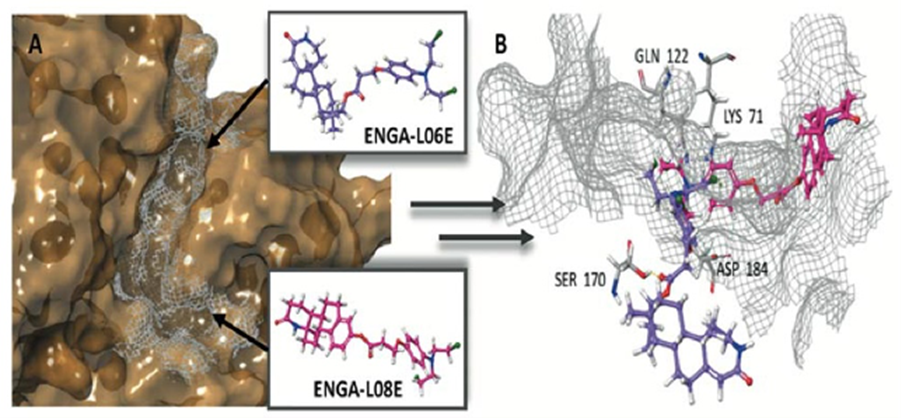
Figure 1. (A) The active site cavity of ERK and (B) Superimposition of calculated molecules ENGA-L06E and ENGA-L08E given in purple and pink colored carbons, respectively, with labeling of the critical bonding residues.
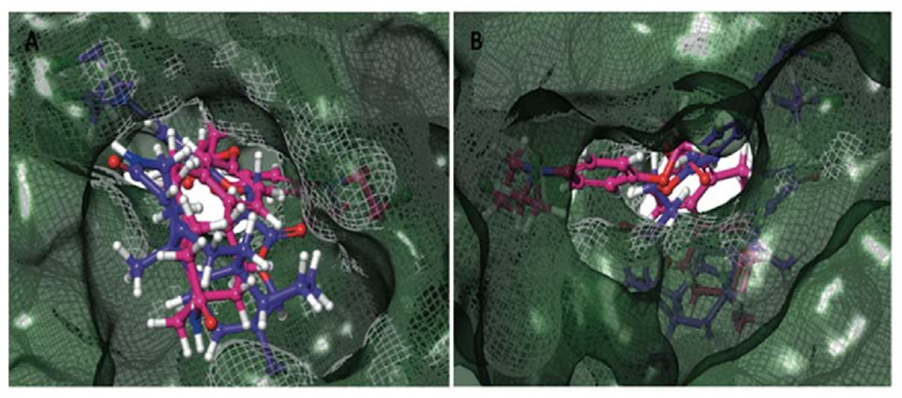
Figure 2. (A) Front side and (B) Backside of the active site cavity of AKT1 (PDB ID 4EJN) with hybrid molecules ENGA-L06E and ENGA-L08E docked and superimposition of calculated molecules ENGA-L06E and ENGA-L08E given in purple and pink colored carbons, respectively
Abstract #2: NEW 1,2,4-TRIAZOLO[3,4-b][1,3,4]THIADIAZOLE DERIVATIVES; Patent International Publication number: WO2018/011414A1 (PCT/EP 2017/067908);
Advantages, Activity and Innovation: Novel pharmacologically active 1,2,4-triazolo-[3,4-b]-1,3,4-thiadiazole derivatives (TADs) were prepared and tested in vitro and in vivo for multi-targeted anticancer activity. TADs demonstrated: (1) High cytostatic and cytotoxic activity against human cancer cell lines, in vitro. (2) High antitumor effects against human tumor xenografts in vivo. (3) Well tolerated systemic toxicity and relatively low acute toxicities, in vivo. (3) High effectiveness against cancer cells resistant to chemotherapeutics as, platinum complexes (cisplatin, carboplatin, oxaliplatin), doxorubicin, irinotecan, paclitaxel). (4) High activity against colon and pancreatic cancer cells that bear K-RAS and/or TP53 mutations. (5) High effectiveness against hormone refractory prostate cancer. (6) High effectiveness against hormone-therapy resistant breast cancer. (7) They induce strong inhibition of phosphorylation and activity of Topoisomerase IIa. (8) They induce strong inhibition of PI3K-AKT-mTOR signal transduction cellular pathway. (9) High activity against tumors that bear KRAS, BRAF, MEK1, PIK3CA mutations. (10) Very high effectiveness against cancer tumors that present defective mismatch repair system (dMMR) with high microsatellite instability (MSI-H). (11) They significantly enhance microsatellite instability in MSI-H cancer cells, as well as in MSI stable (MSS) cancer cells. (12) They trigger the expression of PDL-1 on cancer cells, inducing a dose dependent increment of 80-100% in 2-4 days after treatment. In silico computational and primary in vitro and in vivo studies confirm that TADs act as multi-targeted agents with a novel panel of pharmacological activity.
Other Advantages: (1) The TADs are relatively easily synthesized (in few steps), in high yield (>90%), in standardized scale up procedures and with low total cost. (2) The multi-targeted and multifunctional action of TADs gives the flexibility to apply them in therapy of different cancer types. (3) The TADs could combined with modern therapies, as active and passive immunotherapy, producing synergist anticancer effects.
Potential therapeutic applications: [1] Treatment of certain types of cancer and especially MSI-H cancers. [2] Treatment of chemo-resistant colon, and pancreatic cancer. [3] Treatment of hormone-refractory prostate and hormone- therapy resistant breast cancer. [4] Treatment of m bearing KRAS, PIK3CA and TP53 mutations. [5] Combinatory treatment with active immunotherapy (e.g. anti-PD-1, anti-PD-L1 monoclonal antibodies / Mabs) of cancers susceptible to immunotherapy. [6] Combination treatment of cancers susceptible to passive immunotherapy with anti-EGFR, anti-IGFR, anti-PDGFR, anti-VEGF or anti-VEGFR Mabs.
Patent: A Patent application has already been granted in EU (EP3484892) and has already been filed and granted in other major markets: USA, Canada, Japan, China, Russia, South Korea, Hong Kong, Australia, etc.
Development Stage: Studies have conducted for the lead molecules: In Silico studies, in Vitro and in vivo evaluation (in 28 human cancer cell lines and in 10 human cancer xenograft models), Optimized drug synthesis, Acute toxicity evaluation in mice.
Therapeutic targeting of selected groups of cancer patients and specific indications:
Treatment of MSI-High and Mismatch Repair Deficiency (MMR-D) colon cancer, as monotherapy or in combination with active immunotherapy (Anti-PD-1 / Anti-PD-L1 / Anti-CTLA4 Mabs),
Treatment of MSI-High and Mismatch Repair Deficiency (MMR-D) cancers, as monotherapy or in combination with active immunotherapy (Anti-PD-1 / Anti-PD-L1 / Anti-CTLA4 Mabs),
Treatment of metastatic colon cancers bearing K-RAS or N-RAS mutations and first line treatment with irinotecan and/or oxaliplatin has failed,
Treatment of breast cancer that bear PI3K or PIK3CA mutations or/and are tolerant to mTOR or PIK3CA inhibitors, as monotherapy or in combination with hormone therapy.
Triazolo[3,4-b]thiadiazole derivatives exhibit time- and concentration-dependent inhibition of Akt Ser-473 phosphorylation, and act as ATP binders in the catalytic sites of Akt1 and Akt2.
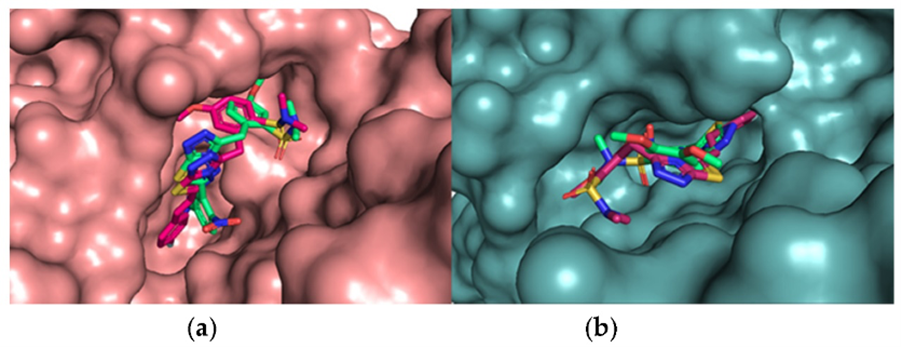
Figure 3. Structures of KA25 (magenta) and KA39 (green) occupying the ATP binding site of (a) 4GV1 (Akt1, pink) and (b) 2JDR (Akt2, blue)
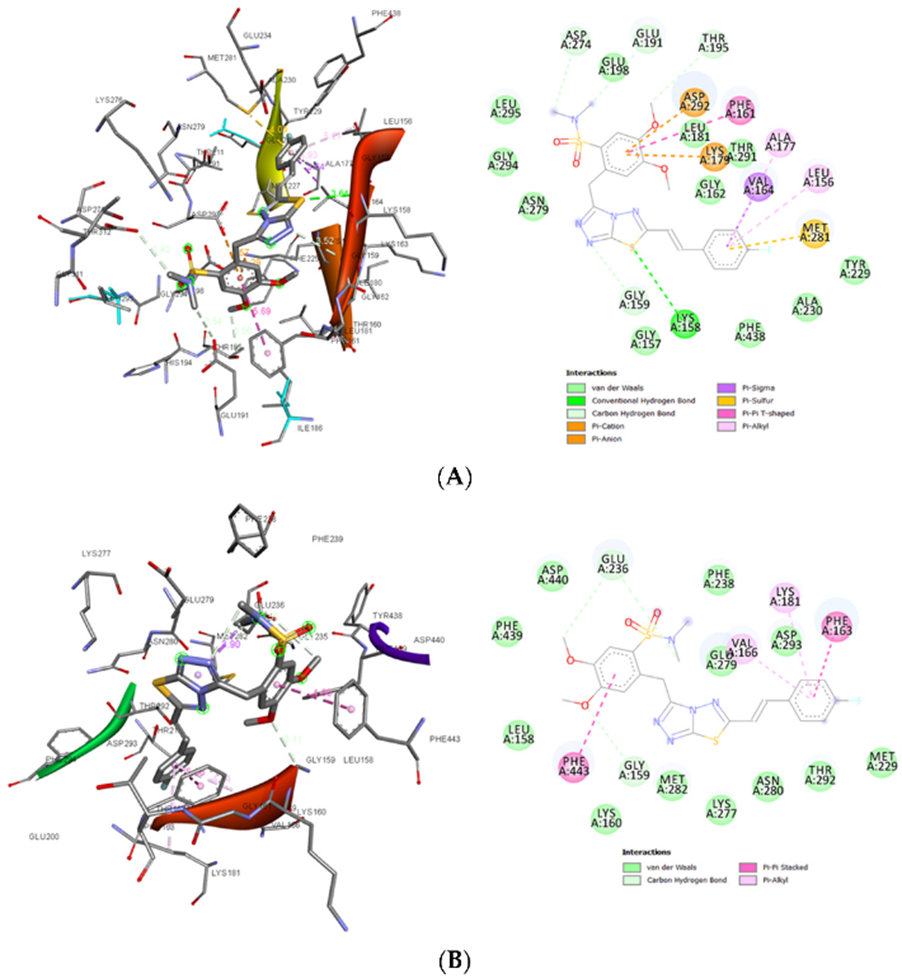
Figure 4. Binding mode of KA25 (left) in the active site of (A) Akt1 (4GV1) and (B) Akt2 (2JDR). Dotted lines in different colors reflect various types of interaction such as hydrogen bonding, charge or polar interactions, and van der Waals and p-sigma interactions
About Cosmos Health Inc.
Cosmos Health Inc. (Nasdaq:COSM), incorporated in 2009 in Nevada, is a diversified, vertically integrated global healthcare group. The Company owns a portfolio of proprietary pharmaceutical and nutraceutical brands, including Sky Premium Life®, Mediterranation®, bio-bebe®, C-Sept® and C-Scrub®. Through its subsidiary Cana Laboratories S.A., licensed under European Good Manufacturing Practices (GMP) and certified by the European Medicines Agency (EMA), it manufactures pharmaceuticals, food supplements, cosmetics, biocides, and medical devices within the European Union. Cosmos Health also distributes a broad line of pharmaceuticals and parapharmaceuticals, including branded generics and OTC medications, to retail pharmacies and wholesale distributors through its subsidiaries in Greece and the UK. Furthermore, the Company has established R&D partnerships targeting major health disorders such as obesity, diabetes, and cancer, enhanced by artificial intelligence drug repurposing technologies, and focuses on the R&D of novel patented nutraceuticals, specialized root extracts, proprietary complex generics, and innovative OTC products. Cosmos Health has also entered the telehealth space through the acquisition of ZipDoctor, Inc., based in Texas, USA. With a global distribution platform, the Company is currently expanding throughout Europe, Asia, and North America, and has offices and distribution centers in Thessaloniki and Athens, Greece, and in Harlow, UK. More information is available at www.cosmoshealthinc.com, www.skypremiumlife.com, www.cana.gr, www.zipdoctor.co, as well as LinkedIn and X.
Forward-Looking Statements
With the exception of the historical information contained in this news release, the matters described herein, may contain forward-looking statements within the meaning of Section 27A of the Securities Act of 1933, as amended, and Section 21E of the Securities Exchange Act of 1934, as amended. Statements preceded by, followed by, or that otherwise, include the words "believes," "expects," "anticipates," "intends," "projects," "estimates," "plans" and similar expressions or future or conditional verbs such as "will," "should," "would," "may" and "could", are generally forward-looking in nature and not historical facts, although not all forward-looking statements include the foregoing. These statements, involve unknown risks and uncertainties that may individually or materially impact the matters discussed, herein for a variety of reasons that are outside the control of the Company, including, but not limited to, the Company's ability to raise sufficient financing to implement its business plan, the impact of the COVID-19 pandemic and the war in Ukraine, on the Company's business, operations and the economy in general, and the Company's ability to successfully develop and commercialize its proprietary products and technologies. Readers are cautioned not to place undue reliance on these forward- looking statements, as actual results could differ materially from those described in the forward-looking statements contained herein. Readers are urged to read the risk factors set forth in the Company's filings with the SEC, which are available at the SEC's website (www.sec.gov). The Company disclaims any intention or obligation to update, or revise any forward-looking statements, whether as a result of new information, future events or otherwise.
Investor Relations Contact:
BDG Communications
cosm@bdgcommunications.com
+44 207 0971 653
SOURCE: Cosmos Health Inc.
View the original press release on ACCESS Newswire
